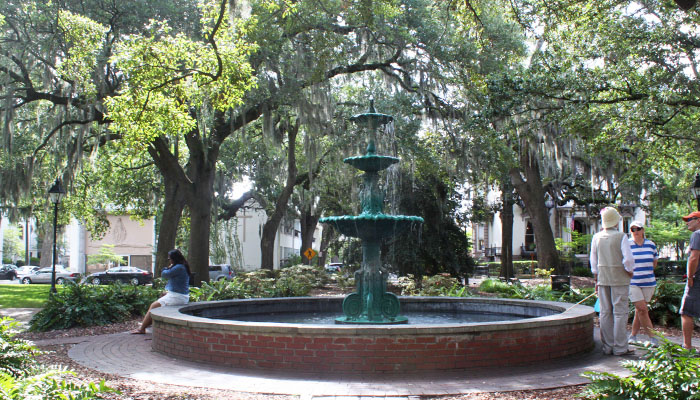
Day 17: Carolina, Here We Come
April 5, 2021
Day 15: Peanut Butter and Pirates on the Road to Florida’s Coast
April 3, 2021Most recently updated on April 10, 2024
Driven on April 9-10, 2024
Originally posted on April 4, 2021
Today, we head in the direction of Georgia.
To get there from St. Augustine, you need to hop onto northbound Highway 1 and then briefly get on Highway 98 north before you merge onto Interstate 295.
That freeway takes you around the eastern outskirts of Jacksonville across the St. Johns River before connecting with Interstate 95.
This roadway is the longest north-south freeway in the United States. It’s the 6th longest overall, but it’s the country’s most used highway in terms of vehicle miles traveled with an average daily traffic volume of 72,000 vehicles.
The freeway serves 110 million people and facilitates 40 percent of the nation’s gross domestic product in a typical year.
Interstate 95 travels along the East Coast from south Florida all the way to Maine’s border with Canada. During its 1,919-mile journey, I-95 goes through 15 states, the most of any interstate in the country. Along the way, it travels through Miami, Richmond, Washington, D.C., Baltimore, Philadelphia, New York City, Boston and Portland, Maine.
It has earned its nickname as the East Coast’s Main Street.
About a half-hour after leaving Jacksonville, you cross the St. Marys River into Georgia.
The Peach State might be bigger and more populous than people realize.
Its nearly 58,000 square miles places it 21st in size nationwide. It’s the largest state east of the Mississippi River, even bigger than Virginia, Pennsylvania and New York.
Georgia has 11 million residents, making it the 8th most populous state, ahead of North Carolina and Michigan. Slightly more than 50 percent of the population is white while 33 percent is Black. The Hispanic/Latino population sits at 10 percent.
Georgia was established in 1732 as a British colony, named after King George II. It was the final and southernmost of the original 13 colonies. It’s also the first of these 13 colonies we visit along our route.
The founders’ original idea was to establish a colony where people who were in British prison for debt could get a fresh start. However, the region quickly changed to a jurisdiction that sought skilled individuals such as bakers, tailors and carpenters.
The leader of the founding group, James Edward Oglethorpe, felt slavery was immoral and had it banned from the colony. However, as the early economy struggled, residents blamed a lack of land ownership and the prohibition of slaves. Oglethorpe returned to England in 1743 and in 1751 the colony’s charter was changed to allow slavery and Georgia became a state known for its plantations and enslaved workers.
The construction of railroads in the 1830s that connected Athens, Augusta, Macon and Savannah pushed the economy forward.
Throughout most of its history, Georgia has had an agricultural economy. It’s the top state in the production of peanuts with more than 50 percent of the nation’s total. The state is also number one in pecans, just ahead of New Mexico. It also has strong sectors for broiler chickens, cotton, cattle and eggs as well as being known for its sweet potatoes.
Tourism is also on the rise in the Peach State. In 2023, the state saw a record $4 billion in tourism revenue.
The manufacturing industry also remains strong. It is led by food and beverage processing as well as textiles. That sector of the economy will soon include electric vehicles, too.
In December 2021, it was announced the automaker Rivian will be building a $5 billion electric truck manufacturing plant less than an hour east of Atlanta. The plans call for a 20 million square foot facility spread across 2,000 acres. The Amazon-backed company expects to have the factory operating in 2026. It will employ as many as 7,500 workers and eventually produce 400,000 vehicles per year. In May 2022, the state awarded Rivian $1.5 billion in tax credits and other incentives to build the plant here. Initial construction began in fall 2022.
Georgia is also about to put a new nuclear power plant into full operation. In October 2022, workers began loading radioactive fuel into Georgia Power’s Plant Vogtle southeast of Savannah. It’s the first new nuclear reactor built in the United States in three decades. The facility is expected to begin full commercial operations in mid-2024, more than seven years behind schedule. Proponents say it will produce cleaner and cheaper energy for Georgia residents.
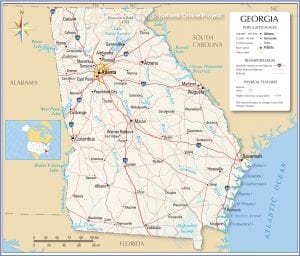
Georgia has also been successful in luring the film industry here. In fact, the state was the leading film production region in the world until 2016 when Canada took over. Georgia is considered the “Hollywood of the South.” In fiscal year 2021, Georgia set a state record with $4 billion in direct spending on productions. In fiscal year 2022, which ended on June 30, the state recorded $4.4 billion in film and television productions. That revenue dipped slightly to $4.1 billion in fiscal year 2023.
The push began in 2008 when then-Governor Sonny Perdue signed a tax incentive program for the film industry. Perdue was apparently peeved that Georgia had lost the production bid for “Ray,” the film about Georgia native Ray Charles, to Louisiana.
In the decade after the incentives were enacted, film production spending in the state rose from $93 million to $2 billion. In recent years, Georgia has been the locale for a number of popular movies and shows, including “The Walking Dead” and “Atlanta.”
Georgia is also in the spotlight over abortion rights. In May 2019, Governor Brian Kemp signed a so-called “heartbeat” abortion law that restricts most abortion procedures after six weeks of pregnancy. In July 2020, a federal judge struck down the law, saying it was unconstitutional. However, in July 2022, a federal appeals court reversed the judge’s ruling and allowed the Georgia law to take effect. In October 2023, the Georgia Supreme Court rejected a bid to overturn that ruling and sent the case back to the appeals court for further review.
Georgia was involved in another Supreme Court decision in spring 2021 when the justices ruled in the state’s favor in a dispute with Florida over water usage on the Flint River. In August 2023, a federal court ruled in Georgia’s favor in another water usage dispute with Alabama.
————————————-
As soon as you cross the border, you came upon the town of St. Marys, a community of 19,000 people nestled along the St. Marys River and Atlantic Coast in the far southeastern corner of Georgia.
Native tribes such as the Timucua, Guales, Creek and Yamacraw lived in the area for centuries.
It was first explored by the Spanish in the mid-1500s. British settlers signed a charter in 1787 to establish the community with 20 people receiving four lots of 4 acres each. The city was incorporated in 1802.
Vice President Aaron Burr came to St. Marys in 1804 after he killed Alexander Hamilton in their famous duel. He stayed at the home of retired Major Archibald Clark. The 5,200-square-foot house was renovated by its owners in 2015.
St. Marys was briefly captured by the British in the War of 1812. It was also shelled by Union ships during the Civil War.
Initially, the town’s economy was centered on its harbor for Atlantic Coast ships. It was one of the places, like Mobile, Alabama, where slave smuggling continued after the importation of slaves was banned in 1807.
The harbor brought growth to St. Marys. In the 1840s, it was Georgia’s fifth largest city.
A lumber mill was built after the Civil War. In later years, canning plants emerged for shrimp, beans and sweet potatoes. Cotton, tobacco and fertilizer production also developed.
St. Marys went through a boom and then a bust in the 1900s.
That economic cycle was featured in “Our Towns,” a book by Deborah and James Fallows in which the husband and wife flew their private plane to towns across America that are reinventing themselves.
In their book, the Fallows describe how Gilman Paper Company dominated the local economy as well as the town itself from its opening in 1941. Its high-paying jobs were offset by Gilman’s political power as well as pollution from the paper mill.
The plant finally closed in 2002, resulting in the loss of 900 local jobs. The plant was demolished and the property has sat vacant for two decades. In November 2022, a groundbreaking was held for the $500 million Cumberland Inlet project, which will turn the site into a mixed-use development with a marina, four-story boutique hotel and multi-family residential units.
In May 2022, the City Council approved a $7 million bond issue to construct a business park at the now-closed St. Marys airport.
In “Our Towns,” the Fallows write about how the U.S. Navy helped turn around the economic fortunes of St. Marys. The Navy opened their East Coast nuclear submarine base here in 1979 to complement the West Coast base they have in Seattle, Washington.
The Naval Submarine Base Kings Bay has had an annual impact of more than $1 billion on the local economy, providing high-paying jobs for well-educated people. That shows up in the town’s median household income of $68,000 per year.
The base has transformed St. Marys in many ways. In their book, the Fallows write that the base is tied to 70 percent of the local economy and it is a far better citizen than Gilman Paper. The change in the local economy seems to have had an impact on the education system. The Fallows write that slackers in high school used to feel they could just get a job at the paper mill. Now, to get a good job at the submarine base or anywhere else, they need to get good grades.
In recognition of the base’s importance, the town has established the St. Marys Submarine Museum. The 5,000-square-foot facility has exhibits on two floors with 20,000 artifacts. It’s dedicated to preserving the history of the “silent service” of submarines and educating the public about the men and women who have served on these underwater vessels. The exhibits include displays on eight submariners who have received the Medal of Honor.
The Charm and History of Savannah
It’s back on Interstate 95 north out of St. Marys.
This section of this workhorse freeway hugs the Georgia coastline as you glide past small towns and numerous islands formed by the various rivers and inlets that feed into the Atlantic Ocean.
After a little less than 2 hours on this scenic drive, you reach the historic town of Savannah.
Savannah is the oldest city in Georgia, having been founded in 1733. That’s when a ship captained by James Oglethorpe landed on the shores here. The vessel carried 114 passengers. King George II had sent them here to establish a town for the working poor. He also wanted to create a buffer between South Carolina and Spanish Florida.
Oglethorpe and the settlers quickly built what became the country’s first “planned city.” The design was based on the town model of London, England, with wards constructed around central squares.
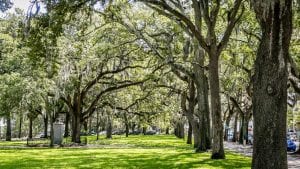
Downtown Savannah, Georgia, is known for its trees and its parks.
The pioneers got along well with the local native tribes and in 1734 approved a law that prohibited slaves, liquor and lawyers. Catholics were also not permitted to live in the community until disputes between England and Spain were resolved in 1748. The liquor ban was lifted in 1742 and the prohibition on slavery ended in 1750. Lawyers weren’t allowed until 1755.
Savannah was an important seaport during the Revolutionary War. By 1820, Savannah was the 18th largest city in the United States and its port was handling exports worth $14 million per year.
Due to its harbor, Savannah was highly sought by Union forces during the Civil War. Savannah was the primary target of General William Tecumseh Sherman during his fiery march to the sea at the end of the conflict. Savannah fared better than other towns because community leaders negotiated a peaceful surrender to avoid being burned to the ground. Sherman penned a famous letter to President Abraham Lincoln where he presented Savannah as a “Christmas present.”
Agriculture was the primary driver of the city’s initial economy. In its early days, Savannah shipped silk and indigo to England. By 1767, almost one ton of silk was being exported to England every year.
The climate was perfect for growing cotton, which quickly became Savannah’s most important crop along with rice. At one point, 90,000 bales of cotton were exported per year, accounting for 80 percent of the agricultural products shipped from Savannah’s port.
It was here that in 1793 Eli Whitney invented his cotton gin at a plantation owned by the widow of General Nathaniel Greene. Whitney had come to Savannah to tutor children, but that job fell through. He accepted an invitation from Greene’s widow to study law while staying at her home. Whitney got the idea for the cotton gin while talking to neighboring planters. Six months later, he had constructed his first cotton-picking machine. His invention made cotton harvesting quicker and easier, greatly expanding the industry in the South.
In 1843, a railroad line from Savannah to Macon expanded the local economy even more as it allowed cotton to be transported from central Georgia to the Savannah port.
The port continued to dominate the economy in the ensuing decades. In 1920, Savannah was the world’s leading port for “naval stores,” which are primarily wood products used in ship building and repair.
Paper pulp and food processing industries also grew.
In 1935, the Union Bag and Paper Company opened a mill in town that employed 500 people at the end of the Great Depression. That company eventually became International Paper and the plant expanded into one of the world’s largest paper factories. At its height, the facility employed 5,500 workers. The pulp smell it emitted was characterized by local residents as the “smell of money.”
Technology has diminished that smell but also reduced the number of workers to 1,700 on the 450-acre site. The mill, though, still turns out more than 500,000 tons of linerboard and paper per year.
Gulfstream Aerospace has been based in Savannah since 1967. The subsidiary of General Dynamics employs more than 10,000 people in Savannah. In November 2021, Gulfstream announced a 7-year expansion plan for its Savannah facility. The company unveiled another expansion in April 2023, one that will add 1,600 jobs in connection with the firm’s newest airplane, the Gulfstream G400.
Nick Zoller, the city’s senior director of marketing and communication, told 60 Days USA in spring 2021 that Gulfstream and Savannah’s port continue to be major employers here.
“We’re proud to be home to a major manufacturer of aeronautical products,” he said.
The Savannah area has a strong military presence. Fort Stewart, the Army’s largest installation east of the Mississippi River, is 40 miles southwest of town. Hunter Army Airfield, a 350-acre facility in Savannah, provides civilian-military support to Fort Stewart. It also features an 11,375-foot runway that allows the Third Infantry Division to deploy personnel and cargo worldwide.
Its port is also an important factor. In October 2023, port officials announced they were moving ahead with plans to build a 400-acre cargo container terminal on Hutchinson Island in the Savannah River.
Savannah has grown to a city with 148,000 residents, the fifth most populous in the state. The city is now 52 percent Black and 36 percent white.
Zoller noted the city had a historic election in 2019 that resulted in a super majority of African Americans on the City Council. Seven of the 9 council members, including the mayor, are African-American. Five of them are Black women.
“That election was certainly a sign of how engaged the African-American community was in that election but also a sign of how much the overall community was engaged,” he said.
Zoller said the new council members have “change messages focusing on all the communities within our city.”
Among other things, the council prioritized creating wealth across the city and providing suitable housing for all residents. As part of that mission, Mayor Van R. Johnson II announced in July 2020 the formation of the Racial Equity and Leadership (REAL) task force.
Another goal was boosting tourism. That plans seems to be working. In 2022, Savannah reported a record number of 17 million tourists who spent nearly $4 billion here. In fact, the tourism industry here has become so bustling that downtown residents are asking city leaders to impose some restrictions to reduce noise and traffic.
Part of the tourism draw here is that Savannah is still known as the “Hostess City of the South” due to its charm and hospitality. It’s also called the “Forest City” because of its urban tree programs.
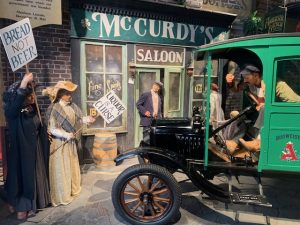
A display inside the American Prohibition Museum in Savannah, Georgia
Part of that forestry system can be found downtown. This area has 22 parklike squares that date back to the original “planned city” design. Each square is shaded by large oak trees.
The city is also home to the American Prohibition Museum, the only facility in the country that showcases the historical efforts to ban alcohol in the country. Savannah was the first area in the nation to prohibit alcohol when it adopted its charter in 1735.
The museum, which opened in 2017, has historical displays of the Prohibition era of the 1920s as well as the illegal establishments that sold liquor. It also shines a spotlight on the nation’s temperance movement, which began in the early 1800s and grew to 6,000 local organizations by 1833. Their main goal was the moderation and, more often, the complete abstinence of the consumption of alcohol.
“The museum highlights an interesting era in the United States, which was also an interesting era in Savannah,” Zoller said.

The Juliette Gordon Low Birthplace museum in Savannah, Georgia, honors the woman who founded the Girl Scouts.
One of Savannah’s historic women is Juliette Gordon Low, the founder of the Girl Scouts. Low was born in Savannah in 1860. Her family home was built in 1821 and her grandparents purchased it in 1831.
Low is featured in Hillary and Chelsea Clinton’s “The Book of Gutsy Women.” In it, they describe how Low was inspired after a meeting in London in 1912 with Lord Robert Baden-Powell, the founder of the Boy Scouts. Baden-Powell said he wanted to form a similar group for girls.
When she returned, Low and her cousin, Nina Anderson Paper, organized a group of 18 girls who met regularly at Low’s house to learn and develop skills. A year later, the group began calling itself the Girl Scouts and published a handbook that showed girls how to splint an arm, extinguish a fire and tie different knots. The group became more active during World War One and began selling their famous cookies. The Girl Scouts took off from there and became the organization it is today.
The family home is now the Juliette Gordon Low Birthplace Museum. There are 40-minute guided tours. Tickets usually sell out quickly as the home is one of Savannah’s most visited sites.
“Especially among Girl Scouts and former Girl Scouts, this is a place you want to go,” Zoller said.
Savannah has its place in movie lore, too. Several scenes from the 1994 movie “Forrest Gump” starring Tom Hanks in his Oscar-winning role were filmed in town. The most famous is the opening scene where the Forrest Gump character narrates while seated on a park bench. That bench was located in Chippewa Square in the city’s entertainment district. The bench is now on display in the Savannah History Museum.
Savannah is also the locale for the flagship restaurant of celebrity Paula Deen.
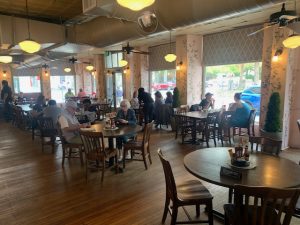
Lady & Sons, Paula Deen’s restaurant in downtown Savannah, Georgia
Her restaurant, Lady and Sons, has been in downtown Savannah since it opened in 1996. Its name is in recognition of her first business venue in which her two sons served as delivery personnel.
Deen is a Georgia native who has certainly had her ups and downs and her share of controversy.
Her life story includes her home-based catering business called “The Bag Lady” to her Savannah restaurant to her show’s 10-year run on the Food Network to her fall from grace after allegations of racism to her return to cable television to her recent cookbooks.
Deen is known for serving up Southern comfort food such as fried chicken, collard greens and broccoli casserole. Many of her recipes are laden with fat, sugar and butter. She’s been criticized for promoting unhealthy foods in a nation facing an obesity crisis.
Like her or not, Deen fits in with the image of Savannah and its downtown horse-drawn carriage tours.
Zoller said Lady and Sons is popular with visitors, but the city also plans to let visitors know about the many other restaurants in town, especially those owned by African Americans.
Overall, Zoller said Savannah provides visitors with different kind of experience.
“Savannah is a very unique place with a unique history,” he said. “The people here are very friendly and very helpful. We’re known as The Hostess City for a reason.”
—————————————
Savannah sits on the border between Georgia and South Carolina.
If you cross the Savannah River, you end up in the Palmetto State.
However, we’re not quite ready to do that, so we turn westward and head into the center of Georgia.
Interstate 16 takes you out of Savannah through some agricultural land but mostly rolling, forested hills.
The freeway is only 166 miles long, short by interstate standards. However, it’s nowhere near the shortest interstate in the country. That honor goes to Interstate 878 in the Queens district of New York City. That roadway is less than 3/4 of a mile in length. In fact, there are 17 interstates in the country less than 2 miles long.
Interstate 16’s primary purpose is to connect the port of Savannah with the city of Macon.
It’s a drive of more than two hours to get here after departing from Savannah. Once you arrive, you’ll find a city of 156,000 people with some interesting musical history.
Macon is nicknamed “The Heart of Georgia” due to its central location in the state.
It’s a town that is 54 percent Black and 37 percent white with an annual median household income of $48,000.
The Macon region is listed as having the highest crime rate in Georgia.
The city also doesn’t score well when it comes to LGBTQ acceptance either. In June 2022, a study by LawnStarter ranked Macon last on a list of 196 cities for LGBTQ friendliness. There is an organization called Macon Pride that is trying to turn that around by sponsoring community events.
The region was first inhabited by native tribes more than 13,000 years ago. Members of the Creek nation lived here when Europeans began settling in the early 1800s.
Fort Hawkins was built in 1806 along the Ocmulgee River as a trading post with tribe members as well as others to provide protection for pioneer settlers. The fort was a major military distribution point during the War of 1812 before being decommissioned in 1822.
Macon was officially founded in 1823 with farmland distributed via a lottery. The city’s early economy thrived due to its proximity to the Ocmulgee River, which allowed for the shipment of goods.
Cotton was a mainstay and the arrival of the first railroad in 1845 expanded market opportunities.
Macon grabbed a niche in history in 1852 when the kazoo was first introduced at the Georgia State Fair as the “Down South Submarine.” The instrument was created by a Macon company in the 1840s.
During the Civil War, Macon was a manufacturing center for the Confederacy. The Findley Iron Works built 80 cannons that weighed 1,500 pounds each between 1862 and 1864. The city was also home to a large prison that housed 1,600 captured Union soldiers. The town suffered heavy casualties during the war and was finally captured in 1865.
The city rebuilt after the conflict. One of the key technological advances was refrigerated railroad cars that allowed the local peach crop to be transported.
In the 1900s, Macon became a transportation hub due to its central location and multitude of railroad lines. Terminal Station was built in 1916 to be a center for the city’s 15 railroads. In the 1920s and 1930s, the station handled 100 arrivals per day.
After World War Two, manufacturing began to take hold. Industrial employment rose from 6,500 in 1940 to 16,000 in 1949. In addition, farmers started to move away from cotton and grew more soybeans as well as raised more poultry.

Macon, Georgia, is known as a transportation center. Photo by Dreamstime.com.
The openings of Interstate 16 and Interstate 75 in the 1960s further cemented Macon’s status as a transportation center.
The economy today is focused on manufacturing, aeronautics, tourism and the medical industry.
In 2012, voters approved a referendum to consolidate Macon’s city government with Bibb County to create the entity Macon-Bibb County. The new set-up officially dissolved the cities of Macon and Payne City as well as the Bibb County government and replaced them with a single agency overseen by a mayor and nine county commissioners. The merger took effect in 2014. In 2018, it was reported that the consolidation had led to budget deficits and shrinking budget reserves. Commissioners reacted by increasing some property taxes. In January 2020, county officials reported a budget surplus.
Macon celebrates its plethora of cherry trees every March with a 10-day International Cherry Blossom Festival. The event, first held in 1982, coincides with the blossoming of 350,000 Yoshino cherry trees in the area.
The city is also home to the Georgia Sports Hall of Fame. It’s the largest state sports museum in the country at 43,000 square feet. It contains more than 3,000 artifacts and more than 400 inductees.
Music is also a big part of Macon’s history.
The city is where singers Otis Redding and Little Richard grew up. It’s also where Capricorn Records set up shop. The facility now houses Mercer Music at Capricorn, a recording studio that also contains a museum for Capricorn Records. Capricorn Sound Studios changed the music scene in Macon, which became the hub of Southern Rock in the 1960s and 1970s.
One of the biggest groups in that genre was the Allman Brothers Band. The group members, along with their friends, family and road crew, lived from 1970 to 1973 in what was known as “The Big House.” The home was near the Capricorn studios, where the band recorded their music. The house is now the Allman Brothers Band Museum. The exhibits include a Fillmore East Room and Duane Allman’s bedroom, where he lived until his death in a motorcycle accident in 1971 at the age of 24.
All of this has prompted city officials to promote Macon as the “Song and Soul of the South.”
Civil Rights, Coca Cola and Tiny Doors
We head north out of Macon on Interstate 75, a Florida-to-Canada freeway that we will discuss further when we spend an entire day on it later in this trip.
After a little more than an hour, I-75 brings us to Atlanta.
This city has grown into a metropolis of nearly 500,000 people, by far the most populous in Georgia.
Atlanta is home to two major cable networks as well as a number of prominent corporations. It also was host to a Summer Olympics and has the densest tree canopy of any U.S. city. And it has a deep history in the Civil Rights Movement.
The region was occupied by the Cherokee and Creek tribe for centuries. Those Native Americans were forced to leave by the federal government in 1822 as part of a major relocation program.
European settlers quickly moved in, building their first homes in 1822. The city was founded in 1837 as an endpoint on the Western and Atlantic Railroad that eventually linked the Southeast to the Midwest.
During the Civil War, Atlanta was a manufacturing and distribution center for military supplies. The city was nearly burned to the ground by General William Sherman during his “march to the sea” assault across Georgia. That destruction was chronicled in the 1939 film, “Gone With the Wind.”
Atlanta rose from the ashes to become a commerce hub centered around its railroads. By 1900, there were 15 rail lines in the city with 150 trains arriving every day. Later in the 1900s, the city diversified its economy by adding education, technology and medical industries.
In the 1960s, it was one of the focal points of the battle for civil rights. In 1961, Black students organized sit-ins to protest segregation in local restaurants. That same year, the city began court-ordered desegregation of its public schools.
The battle for equal rights had an impact on the demographics of the city in the second half of the 20th century. In 1962, the city under court orders began opening up areas of town for Black residential neighborhoods. In response, the white population in Atlanta declined by 60,000 people while the Black populace rose by nearly 70,000.
Between 1970 and 2000, Atlanta’s overall population decreased by 100,000, reaching a low of 394,000 in 1990 with the share of Black residents rising to 67 percent.
Those demographics have shifted since then with more Asians and Hispanics moving in along with college-educated professionals of all ethnicities. The Black population has declined to 47 percent.
The city has been dealing with a rash of killings the past few years. In 2021, there were 158 homicides reported in Atlanta, one more than 2020 and the highest number since 1996. There were 170 homicides investigated in 2022, the third yearly increase in a row. That number, however, fell to 135 in 2023 after the implementation of community-based crime prevention programs.
Economically, the city has soared in recent decades. Its gross domestic product was reported as $455 billion in 2022.
For starters, the city is an airline hub with Hartsfield-Jackson Atlanta International being the world’s busiest airport in terms of daily passenger flights. Delta Airlines, the world’s second largest airline company, has its headquarters here.
Delta is not the only major company that calls Atlanta home base. Other top firms include Coca-Cola, Home Depot, AT&T Mobility, United Parcel Service, Georgia Pacific and Chick-fil-A.
The broadcast industry is also well represented. Both the Cable News Network (CNN) and Turner Broadcasting System (TBS) have operations downtown.
Atlanta is also home to the Centers for the Disease Control and Prevention (CDC).
Atlanta has also worked hard to build up the film industry here. As mentioned when we crossed the state line, Georgia offers generous tax credits to moviemakers. The television series “Atlanta” starring Donald Glover is one of the more high-profile shows based here.
In addition, the 1,000-acre Trilith Studios with 18 sound stages sits 30 miles south of town. The former Pinewood Studio complex was purchased in October 2020 by Trilith Group and renamed. The film, “Captain America: New World Order,” is one of the movies being filmed here and will be released in February 2025.
In 2005, the city initiated a $2.8 billion BeltLine project to turn unused rail lines into 33 miles of walking/biking trails and connect them to homes, stores and restaurants. So far, there are 1,300 acres of green space, 5,600 affordable housing units as well as shops and places to eat. This ongoing development is expected to be completed by 2030.
Atlanta is also known for its trees. About 47 percent of the city’s acreage is covered by tree canopy. That’s the highest of any major U.S. city and well above the national average of 27 percent. Atlanta residents frequently volunteer with local conservation nonprofit Trees Atlanta and have planted 180,000 trees in metro Atlanta since 1985. One of their notable public projects is collaborating with the Atlanta BeltLine to create an arboretum that lines the entire 22 miles of the circular urban trail. The Atlanta BeltLine Arboretum is considered to be the world’s longest linear arboretum and is open for free to the public.
The organization “City in the Forest” is another group that advocates for tree preservation. The CITF and other groups say that Atlanta’s growth is resulting in trees being cut down for new homes. They also would like to change a portion of the city’s ordinances that currently allow developers to take out trees as long as they pay an extra fee.
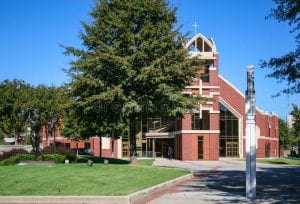
The Ebenezer Baptist Church in Atlanta, Georgia, is part of the Martin Luther King Jr. National Historic Park. Photos by Dreamstime.com,
There are plenty of places to view Atlanta’s history and success.
One of the most prominent is the Martin Luther King Jr. National Historic Park.
The site is dedicated the memory of the Rev. Martin Luther King Jr., a minister by trade who was the primary face of the civil rights movement in the 1950s and 1960s.
King attended segregated schools in Georgia and graduated from high school at the age of 15. He received a bachelor’s degree from Morehouse College in 1948. He earned a bachelor of divinity degree from Crozer Theological Seminar in 1951.
King became pastor of Dexter Avenue Baptist Church in Montgomery, Alabama, in 1954, where he helped lead the two-year bus boycott there. In 1957, he was elected president of the Southern Christian Leadership Conference. Between 1957 and 1968, King traveled 6 million miles and spoke 2,500 times on behalf of the civil rights movement. One of the most memorable of those speeches was his “I Have a Dream” speech in Washington, D.C., in August 1963.
King was named Time magazine’s person of the year for 1963. The following year, he became the youngest recipient of the Nobel Peace Prize at the age of 35. He donated the $54,000 prize money to the civil rights movement.
King was assassinated in April 1968 on a balcony at the Hotel Lorraine in Memphis, Tennessee, while visiting that city in support of striking garbage workers. The hotel is now the National Civil Rights Museum.
The Atlanta park includes the home where King was born in 1929. The two-story house was built in 1895 for a white family. The home was purchased in 1909 by the Rev. Adam Daniel Williams, the pastor of Ebenezer Baptist Church and King’s grandfather. King’s mother lived at the home with her husband and parents when he was born. The home is now a museum.
The site also contains the King Center, which includes exhibits on King, Mahatma Gandhi and King’s wife, Coretta Scott King. The gravesite of Dr. King is also there.
You can also visit Ebenezer Baptist Church, where King was baptized as a child and was co-pastor with his father from 1960 to 1968. The church is where the funeral for Congressman John Lewis was held in July 2020.
Since 2005, the pastor at Ebenezer Baptist has been the Reverend Dr. Raphael Gamaliel Warnock. On January 5, 2021, Warnock was elected along with Jon Ossoff as a U.S. senator from Georgia in a special election that gave Democrats control of the upper chamber of Congress. Warnock was elected again in December 2022.
Not too far away from the church is the Jimmy Carter Presidential Library and Museum, which opened in 1986 as a tribute to the nation’s 39th president. It contains 40 million pages of documents, 1 million photographs and 2,500 videos. President Carter was born in 1924 in Plains, Georgia, about 2 ½ hours south of Atlanta.

More than two dozen 7-inch-high doors are scattered around Atlanta as part of the Tiny Doors ATL art project. Photo by CBS News.
In the downtown area is one of the biggest landmarks in town. Centennial Olympic Park sits on the site of the 1996 Summer Olympics. The 22-acre complex has amenities such as parks, pools and artwork. There’s also the Fountain of Rings with 251 water jets that are utilized for four shows per day. Despite a pipe bombing by a lone terrorist that killed two people, the Olympic games had a lasting economic impact on Atlanta, transforming the downtown area and boosting some of the nearby neighborhoods.
Across the street from Centennial park is the College Football Hall of Fame with 95,000 square feet and 50 interactive exhibits.
Not too far from there is the World of Coca-Cola, a museum that opened in 2007 and is dedicated to Coca Cola products as well as the history of how the soft drink was invented by a pharmacist here in 1886 and how it’s been marketed over the decades.
One of the more unique and perhaps coolest attractions in town is Tiny Doors ATL, an art project that has placed 7-inch doors in public places. The project was started in 2014 by local artist Karen Anderson Singer. She sculpts and places the little doors at the request of neighborhoods and institutions. There is now more than two dozen of the miniature doors scattered around Atlanta. They can be found on the sides of buildings, embedded in tree trunks and other places.
And now, we can now shut the door on Day 16.
Tomorrow, we head east with one more icon in the Atlanta area to visit for breakfast before we depart for the Carolinas.

